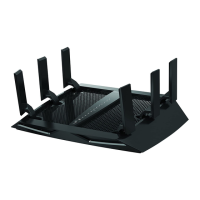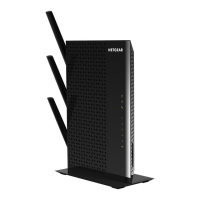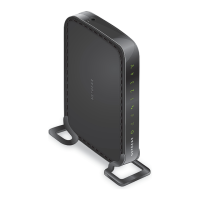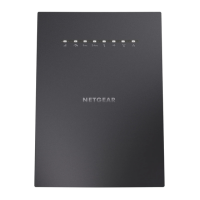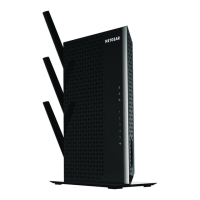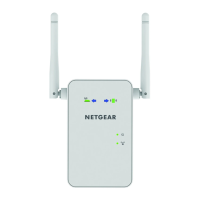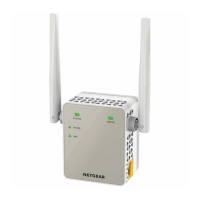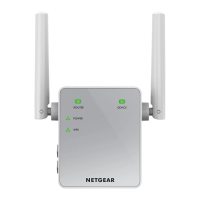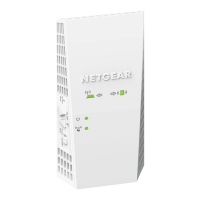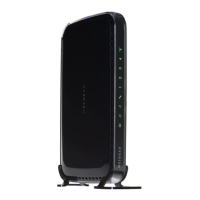Do you have a question about the NETGEAR Nighthawk X6S EX8000 and is the answer not in the manual?
Details the items included in the extender package.
Explains the function of each LED indicator on the extender.
Identifies the ports and buttons located on the back of the extender.
Guidance on optimal placement and usage scenarios for the extender.
Explains the extender's function as a bridge between networks.
Steps for initial setup: placing, powering, and connecting the extender.
Configure the extender to function as a WiFi access point.
Connect computers and devices to the extended WiFi network.
Access the extender's web interface after initial setup.
Use Smart Setup for easy configuration of extender settings.
Configure the extender to use the same WiFi name as the router.
Manage unified 2.4 GHz and 5 GHz network settings.
Display a list of devices currently connected to the extender.
Review the current WiFi network configuration of the extender.
Customize the SSID (network name) for the extender's WiFi.
Hide the extender's WiFi network name for increased privacy.
Control the broadcast of 2.4 GHz and 5 GHz WiFi signals.
Adjust the WiFi speed settings, primarily for the 5 GHz band.
Connect devices to the extender using WPS.
Block specific devices from accessing the network via MAC address.
Schedule when devices can access the Internet through the extender.
Assign a custom name to the extender for easier identification.
Configure a fixed IP address for the extender.
Configure MAC filtering on the router for extender-connected devices.
Update the login credentials for accessing the extender's settings.
Enable or disable the password protection feature for security.
Steps to recover lost login credentials using security questions.
Configure automatic adjustment of the extender's clock for DST.
Manually set the extender's internal clock for accurate scheduling.
Create a backup of the extender's configuration settings.
Load previously saved configuration settings onto the extender.
Reset the extender to its original factory default configuration.
Check for and install the latest firmware for the extender.
Perform a remote restart of the extender via its web interface.
Control the power status indicator LED on the extender.
Specifications and compatibility for USB storage devices.
Instructions for physically connecting a USB drive to the extender.
Access files on a USB drive from a Windows PC.
Assign a drive letter to the USB storage for network access in Windows.
Access files on a USB drive from a Mac computer.
Enable or disable the USB port functionality on the extender.
Create network folders on the connected USB storage.
Secure folders on the USB drive with password protection.
Configure the extender to share a connected USB printer.
Modify the network and device name for the USB share.
Configure DLNA media server settings for streaming content.
Enable TiVo support to access media files on the extender.
Answers to common questions and issues encountered with the extender.
Troubleshoot problems preventing connection to the extender.
Resolve WiFi connection errors when joining a network.
Troubleshoot issues accessing the extender's local web interface.
Guide to locating the extender's IP address on the network.
Details the default configuration settings of the extender.
Provides technical and environmental data for the extender.
Details the items included in the extender package.
Explains the function of each LED indicator on the extender.
Identifies the ports and buttons located on the back of the extender.
Guidance on optimal placement and usage scenarios for the extender.
Explains the extender's function as a bridge between networks.
Steps for initial setup: placing, powering, and connecting the extender.
Configure the extender to function as a WiFi access point.
Connect computers and devices to the extended WiFi network.
Access the extender's web interface after initial setup.
Use Smart Setup for easy configuration of extender settings.
Configure the extender to use the same WiFi name as the router.
Manage unified 2.4 GHz and 5 GHz network settings.
Display a list of devices currently connected to the extender.
Review the current WiFi network configuration of the extender.
Customize the SSID (network name) for the extender's WiFi.
Hide the extender's WiFi network name for increased privacy.
Control the broadcast of 2.4 GHz and 5 GHz WiFi signals.
Adjust the WiFi speed settings, primarily for the 5 GHz band.
Connect devices to the extender using WPS.
Block specific devices from accessing the network via MAC address.
Schedule when devices can access the Internet through the extender.
Assign a custom name to the extender for easier identification.
Configure a fixed IP address for the extender.
Configure MAC filtering on the router for extender-connected devices.
Update the login credentials for accessing the extender's settings.
Enable or disable the password protection feature for security.
Steps to recover lost login credentials using security questions.
Configure automatic adjustment of the extender's clock for DST.
Manually set the extender's internal clock for accurate scheduling.
Create a backup of the extender's configuration settings.
Load previously saved configuration settings onto the extender.
Reset the extender to its original factory default configuration.
Check for and install the latest firmware for the extender.
Perform a remote restart of the extender via its web interface.
Control the power status indicator LED on the extender.
Specifications and compatibility for USB storage devices.
Instructions for physically connecting a USB drive to the extender.
Access files on a USB drive from a Windows PC.
Assign a drive letter to the USB storage for network access in Windows.
Access files on a USB drive from a Mac computer.
Enable or disable the USB port functionality on the extender.
Create network folders on the connected USB storage.
Secure folders on the USB drive with password protection.
Configure the extender to share a connected USB printer.
Modify the network and device name for the USB share.
Configure DLNA media server settings for streaming content.
Enable TiVo support to access media files on the extender.
Answers to common questions and issues encountered with the extender.
Troubleshoot problems preventing connection to the extender.
Resolve WiFi connection errors when joining a network.
Troubleshoot issues accessing the extender's local web interface.
Guide to locating the extender's IP address on the network.
Details the default configuration settings of the extender.
Provides technical and environmental data for the extender.
| WiFi Technology | 802.11ac |
|---|---|
| Number of Ethernet Ports | 4 |
| Ethernet Port Type | Gigabit Ethernet |
| MU-MIMO | Yes |
| Beamforming | Yes |
| Smart Roaming | Yes |
| Smart Connect | Yes |
| FastLane Technology | Yes |
| WiFi Performance | AC3000 |
| WiFi Band | Tri-Band |
| Security | WPA2 wireless security protocols |
| Weight | 1.9 lbs |
| Operating Temperature | 32° to 104°F (0° to 40°C) |
| Operating Humidity | 10% to 90% non-condensing |
| Storage Humidity | 5% to 95% non-condensing |
| USB Ports | One (1) USB 3.0 port |
| Storage Temperature | -4° to 140°F (-20° to 60°C) |
